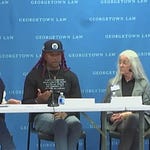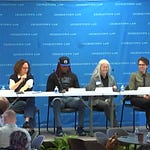The Midwest, and Minnesota in particular, are traditionally seen as repositories of America’s most cherished values. A significant number of First Amendment cases in the state have shaped the boundaries and protections of free expression. In Near v. Minnesota (1931), for example, the Supreme Court ruled in favor of a rogue newspaper that accused local officials of being implicated with gangsters; the case was later cited as a precedent for upholding publication of the Pentagon Papers. A more recent ruling, Minnesota Voters Alliance v. Mansky (2018), maintained that a state law prohibiting individuals from wearing political apparel around polling places was unconstitutional. How have these and other cases contributed to the evolving understanding of Free Speech rights? Is there a dark side to this history?
Featuring Suki Dardarian, editor and senior vice president, The Star Tribune; Leita Walker, litigator, Ballard Spahr; T. Anansi Wilson, associate professor, Mitchell Hamline Law School; and Sid Bedingfield, professor and Cowles Research Fellow in Journalism, Democracy, and Race, Hubbard School of Journalism and Mass Communication, University of Minnesota.
Summary
This conversation explores Minnesota's complex history with free expression, focusing on the state's past and present challenges regarding free speech, media rights, and the regulation of protests. Panelists discuss the implications of historical laws, current issues in journalism, and the impact of digital technology on public awareness and accountability. The conversation explores the complex relationship between media, accountability, and the judicial system, emphasizing the dual-edged nature of social media and body cameras in promoting transparency while also raising concerns about privacy and bias. It discusses the evolving role of cameras in courtrooms, the threats faced by journalists, particularly those from marginalized communities, and the broader implications of policing practices in the context of global democracy.
Keywords
Minnesota, free expression, journalism, protests, media rights, public records, police accountability, digital technology, racial justice, government transparency, media accountability, judicial transparency, press freedom, policing, social media, body cameras, racial bias, AI, truth, democracy
Takeaways
The history of free expression in Minnesota is marked by significant challenges and ongoing issues.
Access to police records remains a contentious issue in Minnesota.
The state's approach to protests and dissent reflects a broader national trend of regulation and intimidation.
Journalistic freedom is often compromised by police hostility and lack of transparency.
There is a cultural disconnect between public officials' statements and the realities faced by journalists and protesters.
The Data Practices Act creates barriers to transparency and accountability in government.
Digital technology has amplified public awareness of issues related to police violence and free expression.
The narrative around free speech must include the experiences of marginalized communities.
Efforts to protect privacy often hinder accountability in public service.
The need for systemic change in how public agencies view transparency and accountability is critical. Media forces accountability but complicates privacy.
Social media can both reveal and obscure the truth.
Judicial transparency is evolving with new camera rules.
Judges fear social media's impact on court proceedings.
Cameras in courtrooms may improve transparency but raise concerns.
Racial bias in policing is exacerbated by media exposure.
Black journalists face unique threats in their reporting.
Speech has always been contextualized and not truly free.
The narrative of America as a liberal democracy is challenged.
Global perceptions of policing are influenced by U.S. practices.
Sound Bites
"It's still a checkered present, if you will."
"The impulse across the country is almost always violence."
"Our coverage was inhibited."
"The message is not trickling down."
"It has forced a lot of people to bear witness."
"It's in your face."
"What do you do about it?"
"The truth is elusive."
"Social media is the number one threat to court access."
"Judges are so afraid of what's gonna get on social media."
"Cameras in the courtroom are a good thing."
"Speech has never really been free."
"The ideals of whom and for whom?"
Chapters
00:00 Introduction to Minnesota's Free Expression History
04:46 The Checkered Past of Free Speech in Minnesota
12:38 Protests and the Regulation of Dissent
20:07 The Role of Media and Journalistic Freedom
26:42 The Disconnect in Transparency and Accountability
33:09 Digital Technology's Impact on Free Expression
34:44 The Impact of Media on Accountability
41:09 Judicial Transparency and the Role of Cameras
48:20 Threats to Press Freedom and Journalistic Integrity
55:32 The Global Context of Policing and Democracy














Share this post